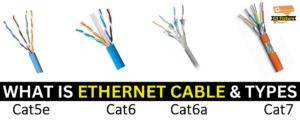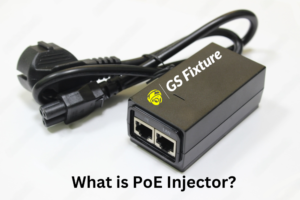What Is RJ45 Connector?
A typical type of connector for Ethernet networking is RJ45. It resembles a phone jack in appearance but is a little wider. Ethernet cables are frequently sometimes referred to as RJ45 cables since they have an RJ45 connector on each end.


Given that it is a standardized networking interface, the “RJ” in RJ45 stands for “registered jack.” The “45” just denotes the interface standard’s number. An RJ45 cable has eight independent wires since each RJ45 connector has eight pins. The eight wires, each of which has a different color, may actually be seen if you look closely at the Ethernet cable’s end. While the remaining four are striped, four of them are plain colors.
There are two ways to wire RJ45 cables. The T-568A variant and the T-568B version are both available. Here is a list of these wiring regulations:
Technical Definitions for RJ45:
The majority of common Ethernet data cables contain an eight-wire core made up of four twisted-pair wire strands. These eight distinct wires are correctly divided and terminated with male RJ45 connectors. In other words, the 8P8C (8 positions, 8 contacts) design is the foundation of RJ45 wiring.
An 8P8C body with a mechanically-keyed variation is referred to as a standard RJ45. RJ45 connectors are effectively mechanically keyed if they have an additional tab. By adding an additional tab, they can’t be connected to any other socket standards that are physically identical but electrically incompatible. Furthermore, it avoids unintentional disconnections.
The eight Ethernet cable wires need to be placed into the appropriate pinout places on the male connection for an RJ45 network connector to work properly. This is carried out via RJ45 in accordance with the T568A or T568B wiring standards. These standards achieve two separate forms of connectivity through the use of individual color-coded wiring conventions.
How to Connect a Cable to an RJ45 Connector:
Only a few basic tools are needed to attach your own male RJ45 plugs at the end of a suitable network communication line. In most cases, it is less expensive to fix a new connector than to replace a whole Ethernet cable. You may elect to wire them yourself for the following reasons as well:
You can cut your Ethernet cable to specific lengths if you know how to wire an RJ45 connector plug. This is helpful for generating very long runs or neatly handling cables.
Stress factors at connection points have the potential to break RJ45 plugs and sockets. This occasionally occurs when a cable is too short, is yanked, or becomes tangled. Pressure on RJ45 connections should typically not exceed 20 lbs.
Although most RJ45 connectors’ polycarbonate plastic is fairly durable, it can eventually wear out or shatter. Incorrect plug and socket insertion and removal might harm the plug or socket. Plugs might become looser over time from frequent switching between sockets. An RJ45 connector can break, shatter, or detach as a result of the impact.
Making your own cables’ wiring can also significantly reduce costs if you want to create a lot of them.
RJ45’s T568A and T568B Wiring Conventions:
When wiring an RJ45 socket to an Ethernet wire, there are two possible electrical connections that you might make. The types you create will depend on whether you utilize the T568A or T568B wiring standard.
These define which eight distinct Ethernet cable wires join to an RJ45 connection and in what sequence. The T568A arrangement is typically regarded as the best since it provides greater backward compatibility than other wiring methods. T568B is more prevalent, especially with slightly older cables and equipment, nevertheless.
The main distinction between the two standards’ respective color schemes is the reversal of the orange and green color combinations. For the type of connection, you are attempting, you must ensure that you are utilizing the appropriate wiring standard.
T-568A Color Coding:
Place the wires in the following configuration for the pin Color Code per T568A.

T-568B Color Code:
Pairs two and three are switched in the type T568B pin assignment. The following is the proper pin Color Code:

Although many devices also support the T-568A wiring scheme, the T-568B wiring scheme is by far the most used. A crossover Ethernet cable with a T-568A connector on one end and a T-568B connection on the other is necessary for some networking applications. When a router, hub, or switch is not accessible, this kind of cable is often utilized for direct connections between computers.

RJ45 Working Principle:
Do you know how it functions when you attach the RJ45 connector to the Ethernet cable’s end and insert it into the Ethernet port?
An RJ45 network connector has eight gold-plated contacts, each of which is separated by insulating plastic layers. Some connections come with three-prong contact pins, while others have two-prong contact pins. When a crimping tool presses the RJ45 connectors, these prongs will “bite” into each wire. The male and female connections of the RJ45 network connector will make contact with one another once it has been inserted into the Ethernet port. The Ethernet wire then started to transmit data and signals.
RJ45 Connector Components:
Even though you may never learn about the RJ45 network connector’s pieces, it has a number of crucial bits.
The plastic housing and the contacts with the gold plating are the two major components of RJ45 connections. A high-performance PC plastic shell is a common feature of an excellent Ethernet connector. In order to link with the eight wires in the Ethernet cable, it also has eight channels and gold-plated connectors.
Two-prong and three-prong contacts are both available in gold plating. While three-prong connections can be used with both solid and stranded wires, RJ45 connectors with two-prong contacts are intended for stranded cable wires. The cable wire can be fixed with three-prong connectors to ensure a secure connection. Additionally, shielded RJ45 connections have a metal shielding framework to assist in reducing interference.

A strain latch and retention latch are included with an RJ45 connector. The retention latch is intended to secure the network cable and prevent it from falling off, whereas the strain latch is intended to make the RJ45 connection snap in the interface and avoid being loose. When inserting or removing the modular plug, don’t forget to press the retaining latch.
Different types of insulated conductor holes are used in various RJ45 connections. While Cat6 connectors often feature a staggered pin configuration, Cat5 connectors have eight neatly placed insulated conductor holes. However, this is not the norm and varies amongst manufacturers.


